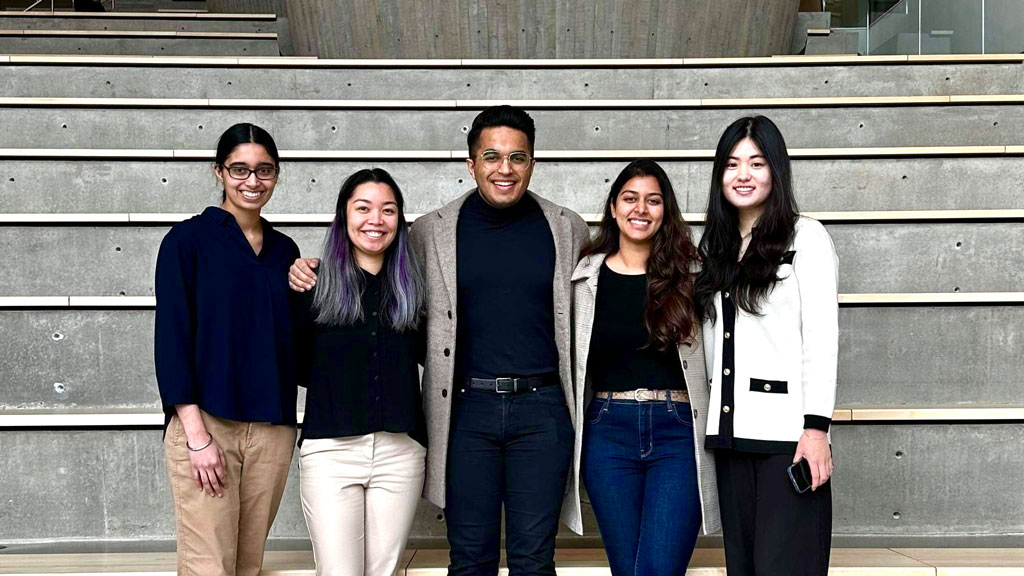A team of five multitalented scholars from Simon Fraser University (SFU) has been named the winner of a Canada Green Building Council award for students for demonstrating excellence in sustainable design in the field of green building and communities.
The team of Gurvaani Dhani, Manin Khunger, Simran Pandher and Clara Park, led by team leader Danielle Arciaga, are the winners of the CaGBC’s Andy Kesteloo Memorial Project Award, named for a dedicated green building advocate.
The students are recent graduates of SFU’s Sustainable Energy Engineering program. The project was titled Deep Retrofit Study for SFU – Exploring Energy Conservation Measures and proposed a plan for the decarbonization of the Discovery 1 Building at SFU’s Burnaby, B.C. campus.
Arciaga recalled when she got the call they had won.
“It was really exciting when we got the news,” she said. “The news spread throughout the office, and in our other friends’ office too, so that was really exciting.”
The project fit with the university’s 2025 Sustainability Plan and consisted of a study of energy conservations measures (ECM) that considered the building’s mechanical system, lighting system, building envelope, onsite renewable energy generation and building automation. Various methods were considered to reduce the energy demand, such as occupant awareness, continuous commissioning of the building and efficient mechanical systems.
A model was created to assess the ECM recommendations along with a climate risk assessment for further plans to improve the performance of the building.
Arciaga explained the team focused on three types of retrofits after originally reviewing 14. A matrix was used to decide on the most feasible, “bang for buck” retrofit, she said.
“We ended up focusing on the building envelope, the building windows and the mechanical system. We saw that there were opportunities there to improve the building performance by updating the windows and envelope and also upgrading some of the mechanical systems to move away from fossil fuels like natural gas, and then switching to electricity.”
The project stemmed from the students’ obligation to undertake a capstone project to fulfill their degree requirements. The students, all in the same year in the relatively new faculty, were all friends who worked together well.
“Our team had a lot of interest in the building sector, from all the different facets,” said Arciaga. “We had interest in the marketing, economy-of-real estate aspect of buildings. We had someone interested in the HVAC system, the electrical side, smart cities, building envelope and performance.”
Dhani was keen on policies and building envelope and performance, Arciaga said; Khunger specialized in marketing and economics which helped with costing and feasibility analysis; Pandher brought intelligence to analysis of the HVAC system and electrical solutions; and Park has a strong research background, Arciaga said, and led the charge in the climate risk assessment.
“Having a group with a diverse knowledge base was very helpful in terms of making this project successful,” she said.
The others selected her as group leader, Arciaga said, because she was “really gung ho about doing this project,” having previously done a course for building modelling under faculty professor Mehran Ahmadi.
CaGBC CEO Thomas Mueller said in a statement, “It is great to see students combine theory and practice on real-life projects and participate in greening the buildings they actually use. The scope of this project is similar to projects completed by professional firms and that’s just additional evidence that sustainability students can be change agents before graduating.”
Arciaga said the team has shared its analysis with SFU facilities and she hopes the property division eventually acts on it and implements the retrofits, or uses it as a stepping stone to do their own investigation into what works best for the building.
The team leader said she is enjoying working in the field as a building performance engineer at RJC Engineers and believes she and her classmates have been groomed for success by their studies at SFU.
“What’s great about our program is that it touches on a wide field, from mechanical all the way to electrical, and touching on policies. So it’s nice that our program has given us a pathway and set us up for success in this field.”



Recent Comments
comments for this post are closed